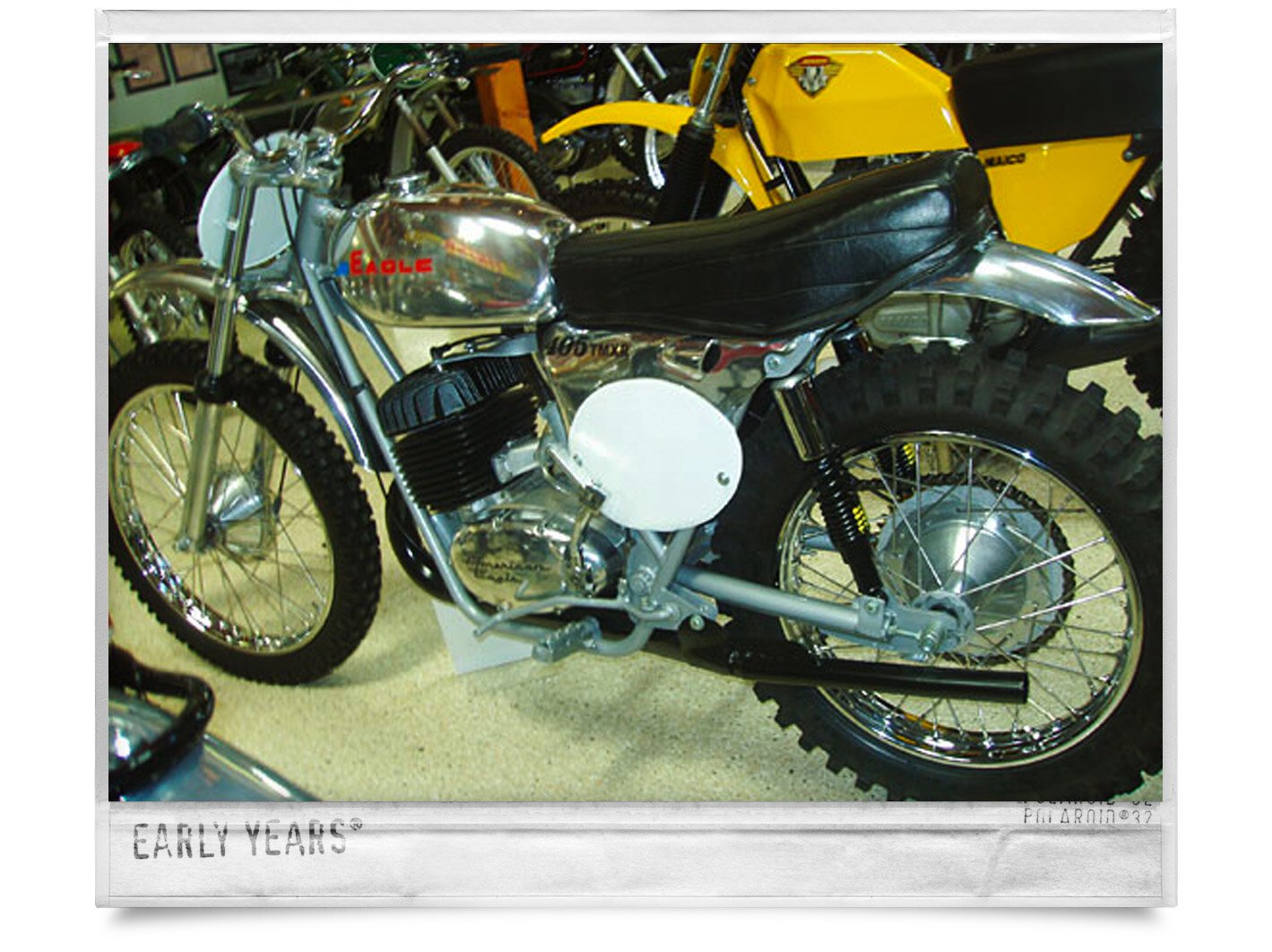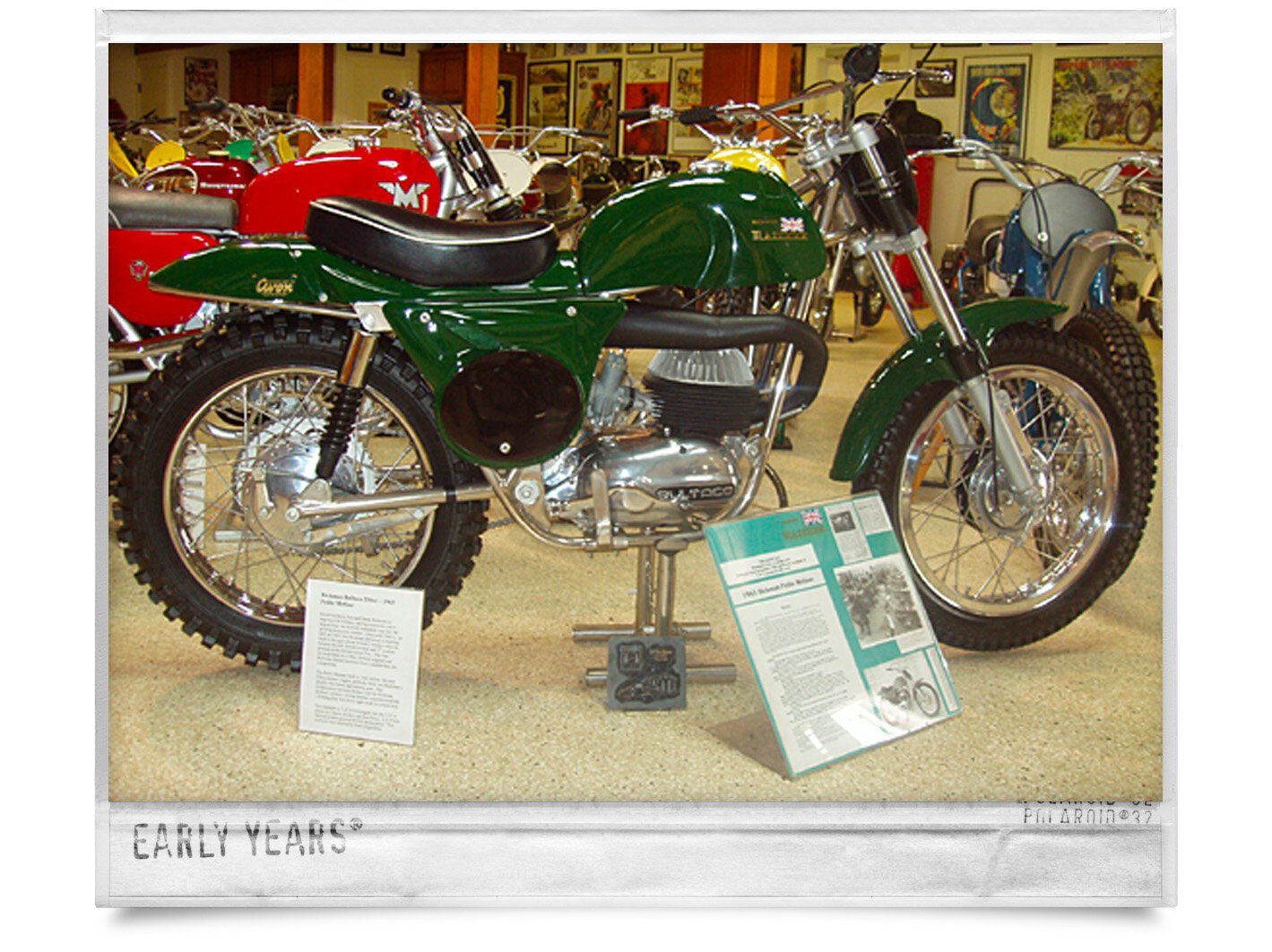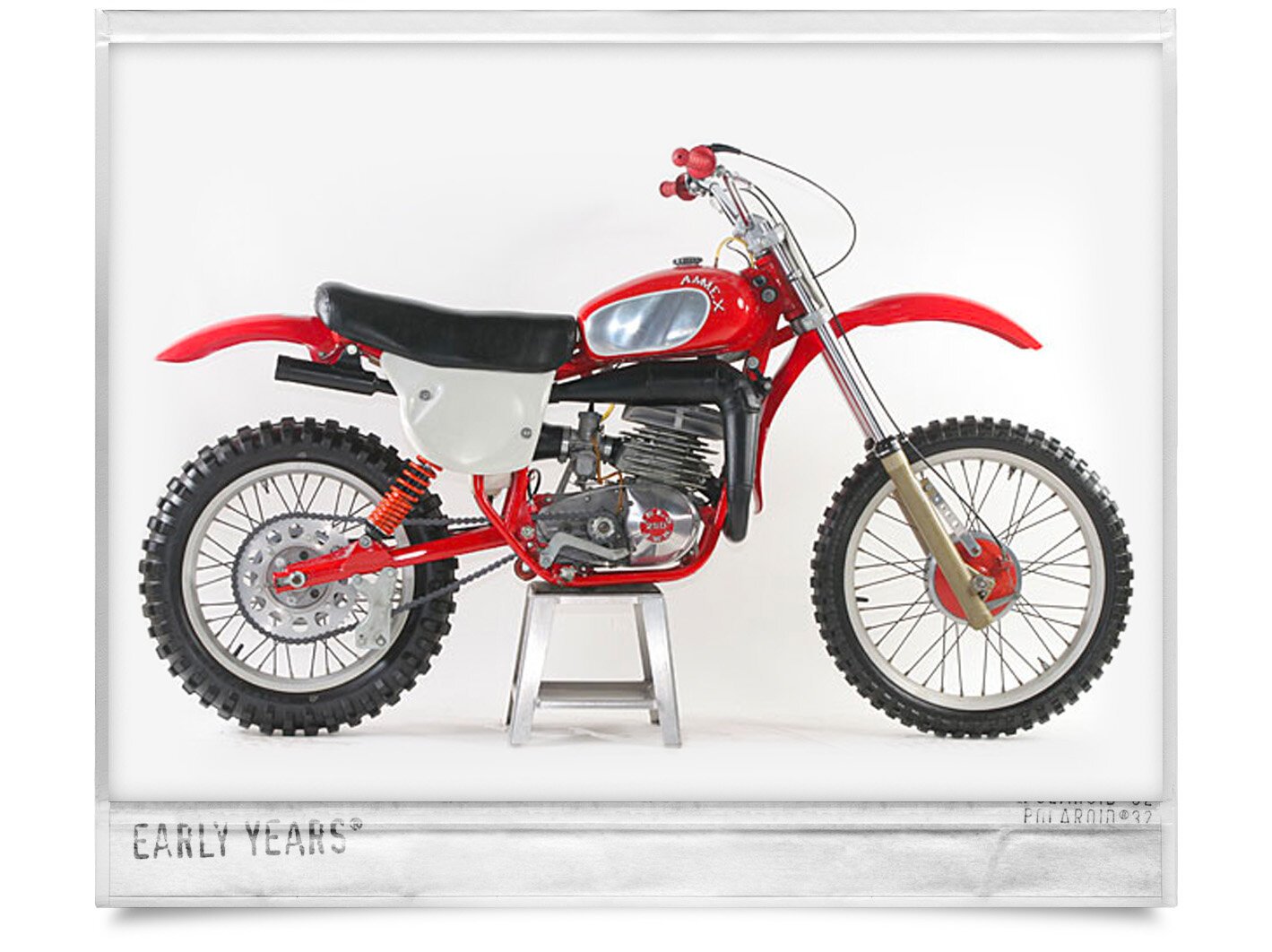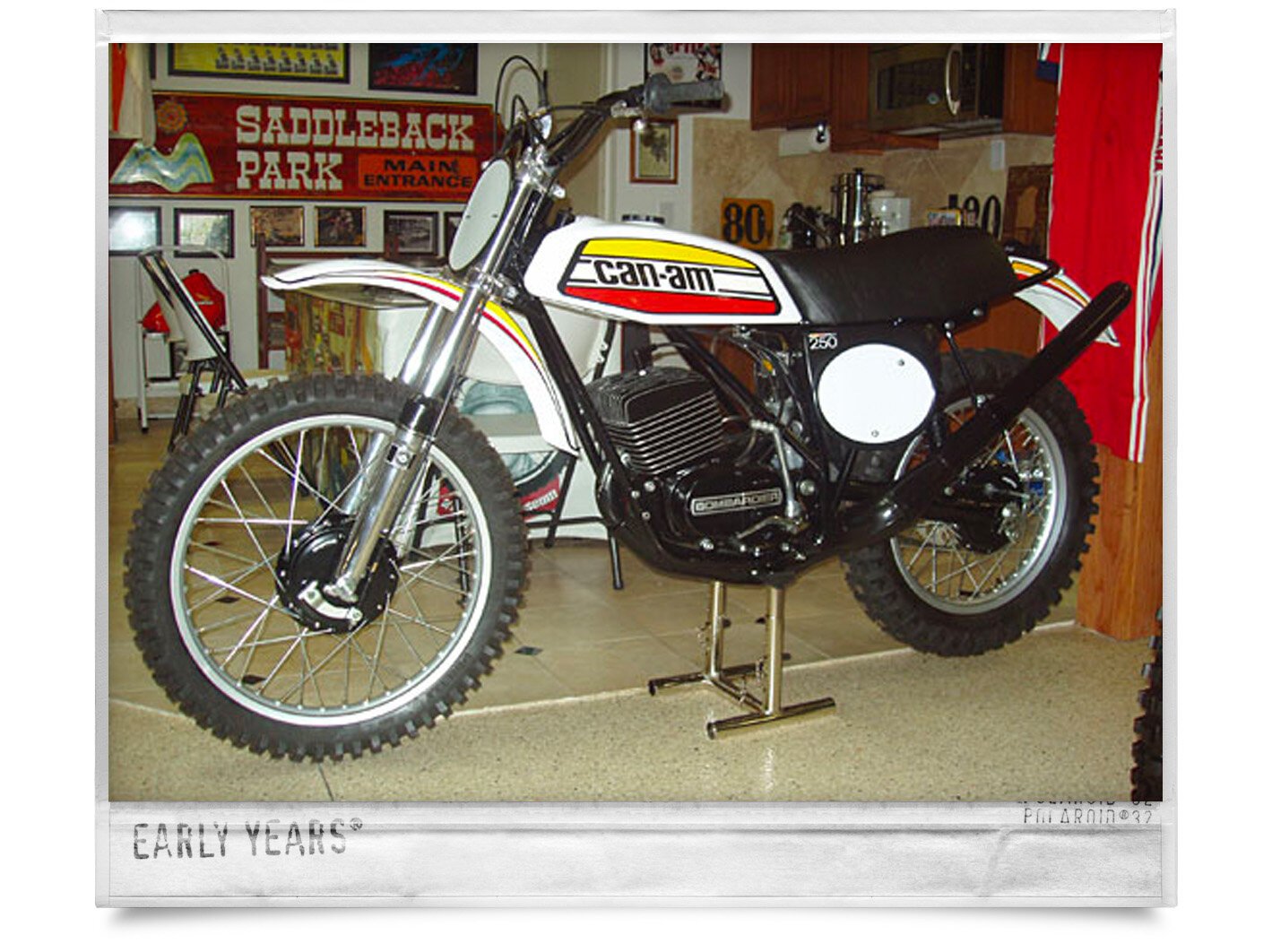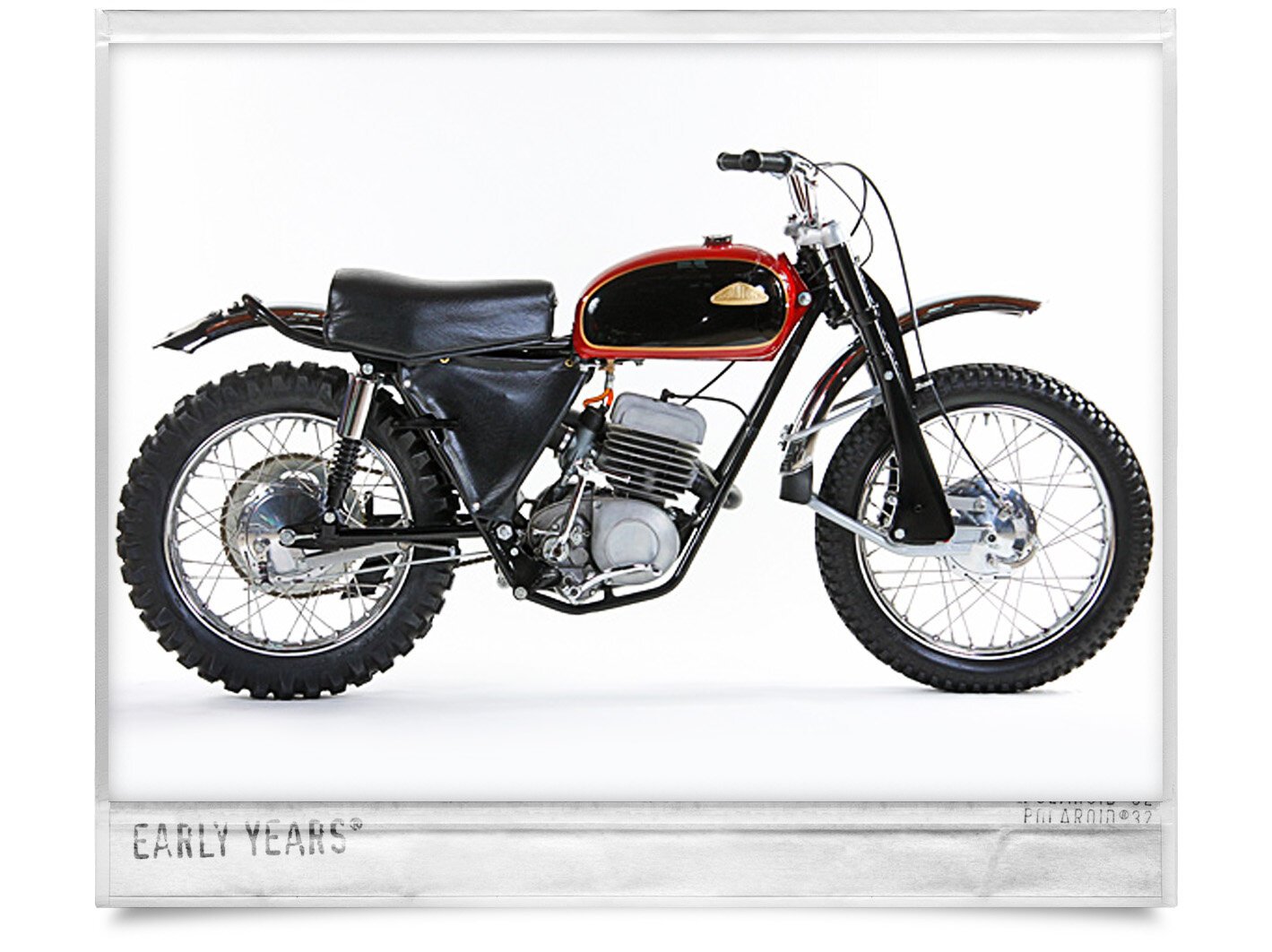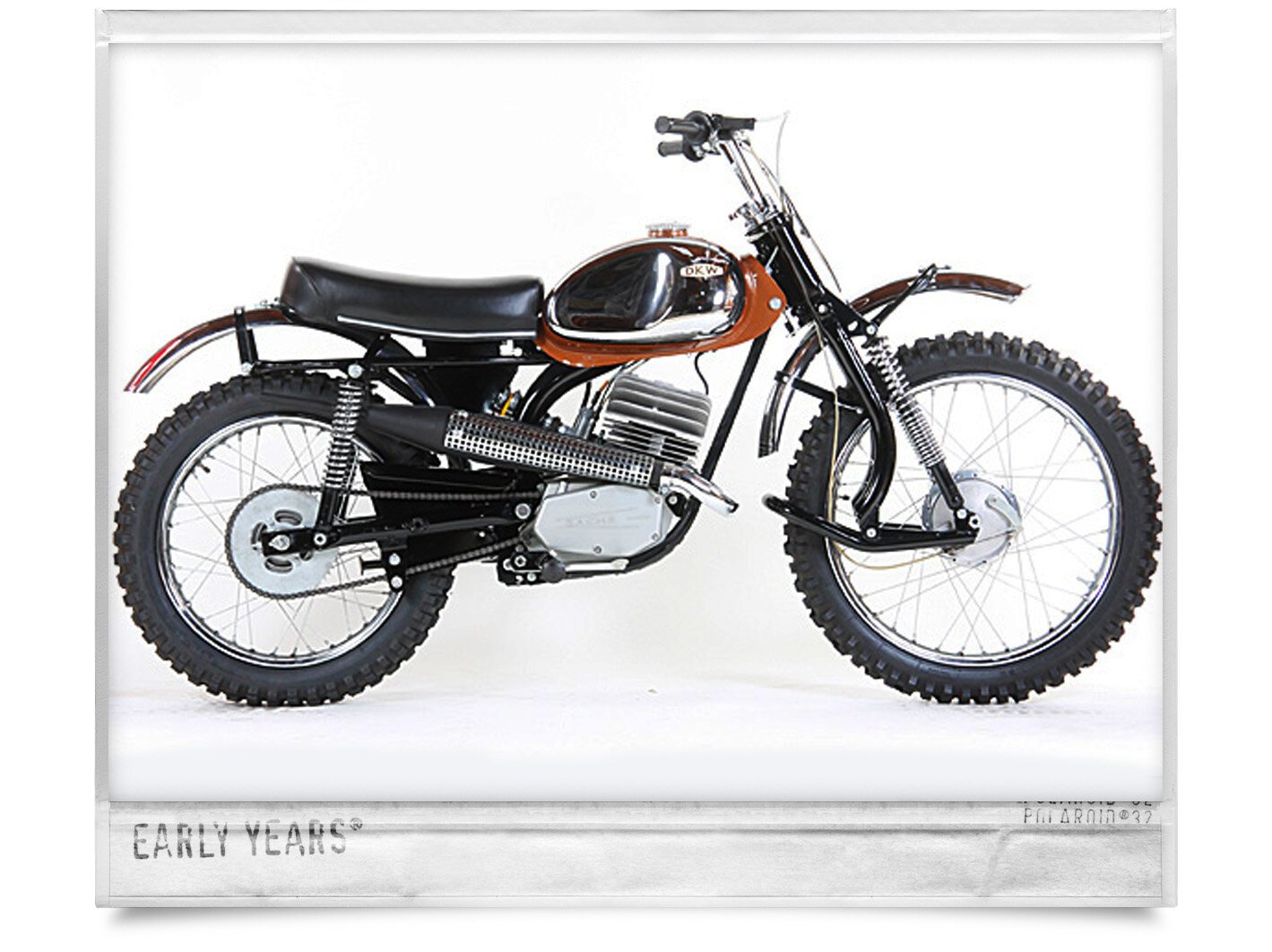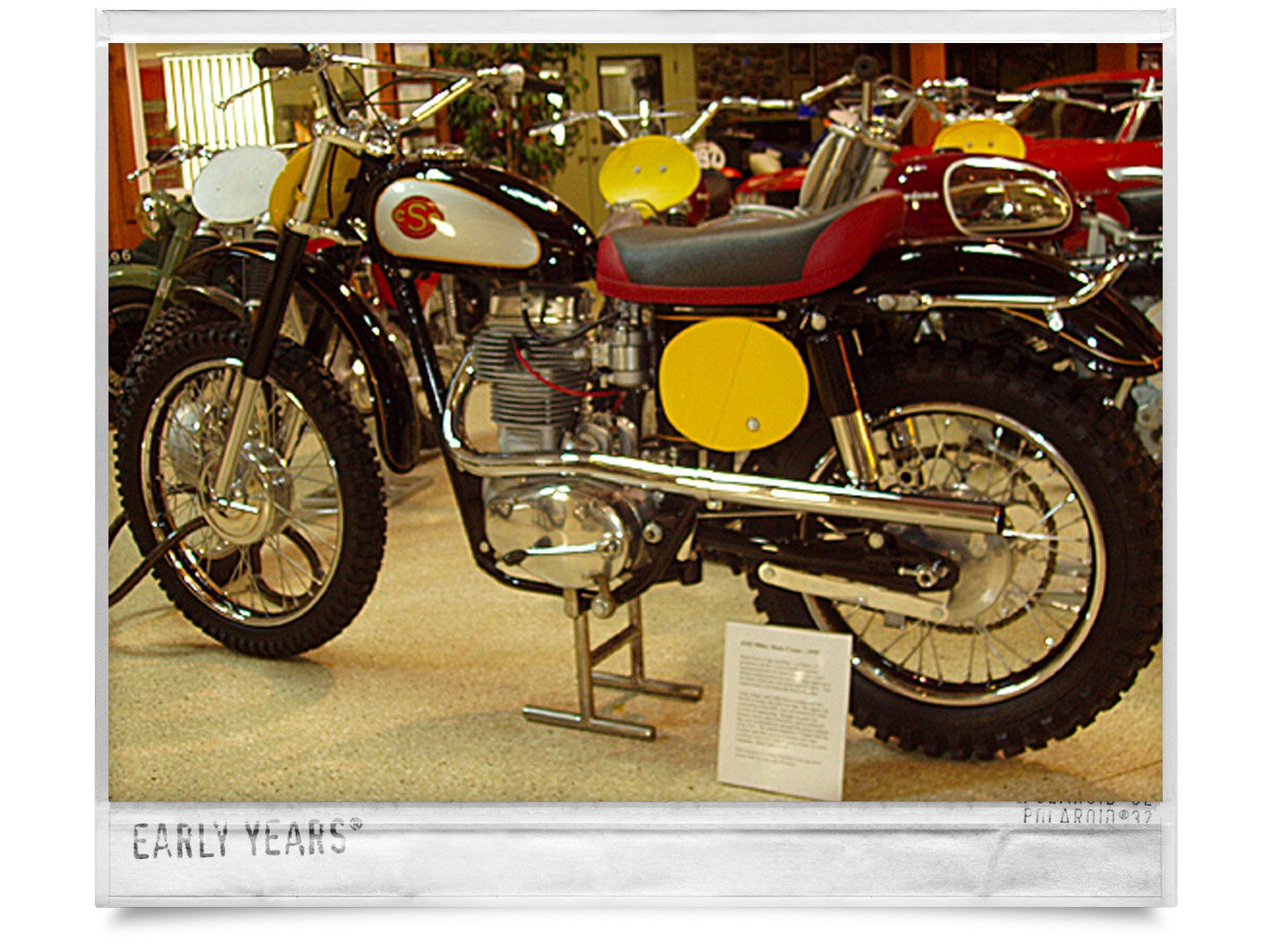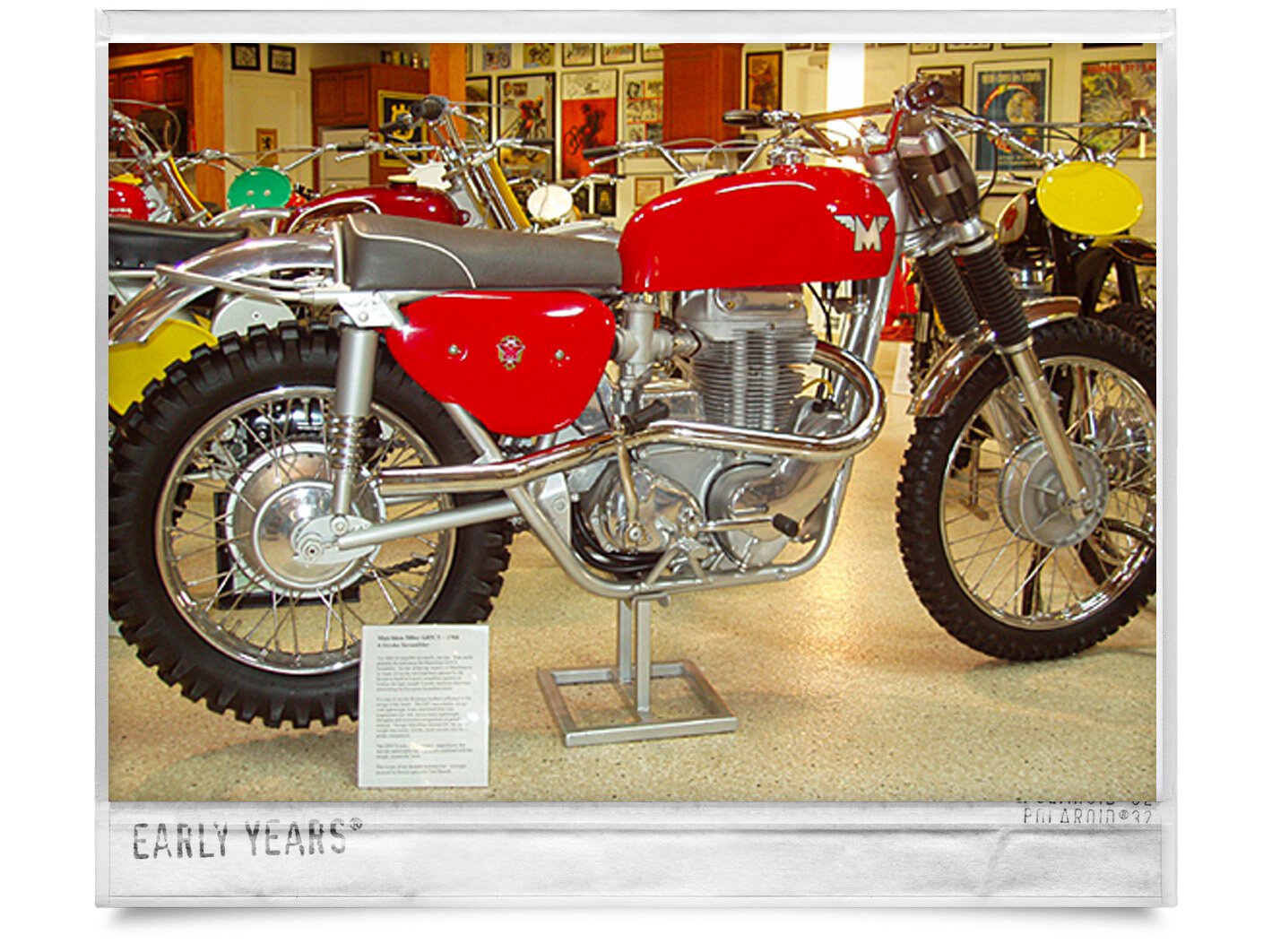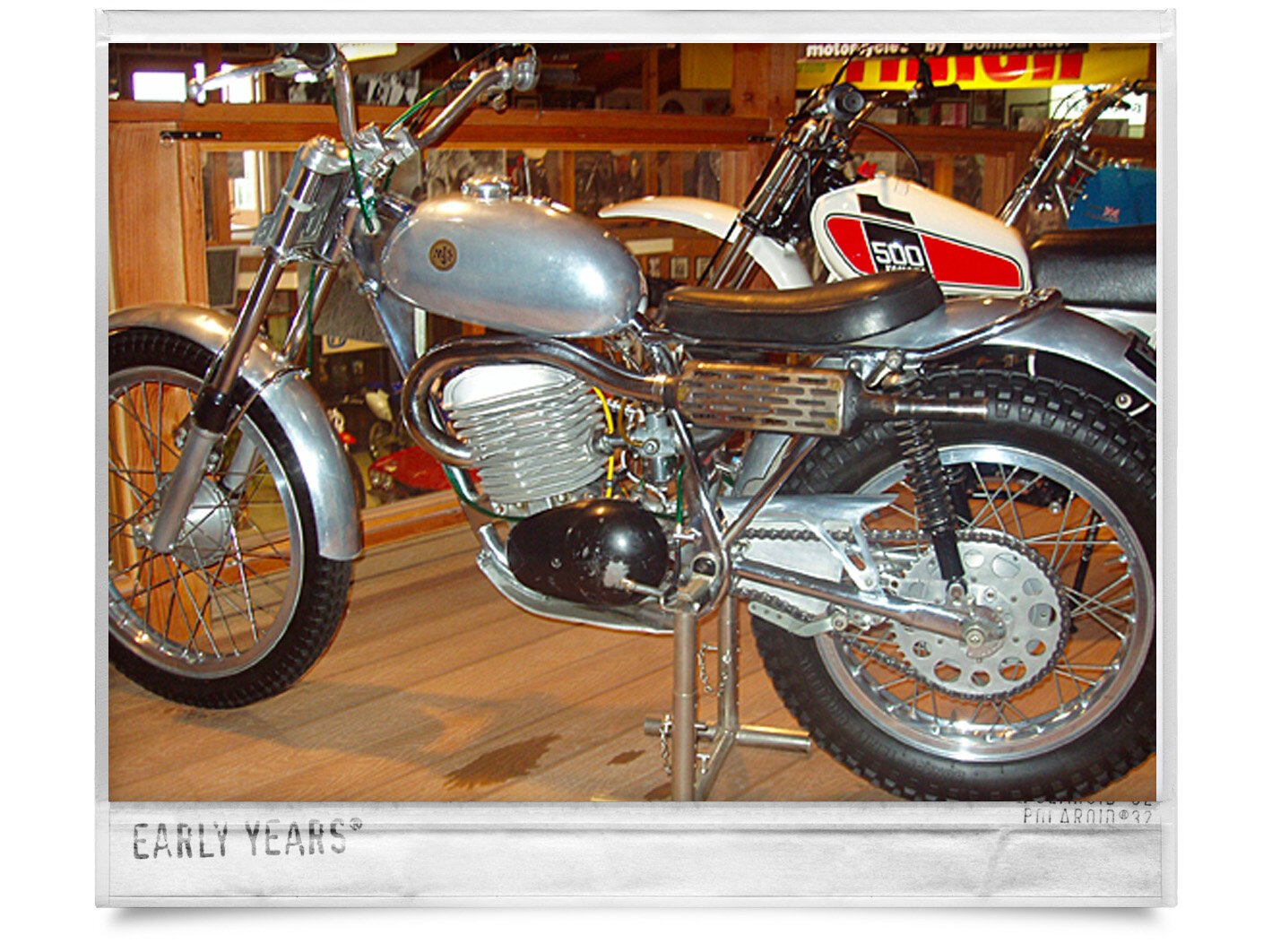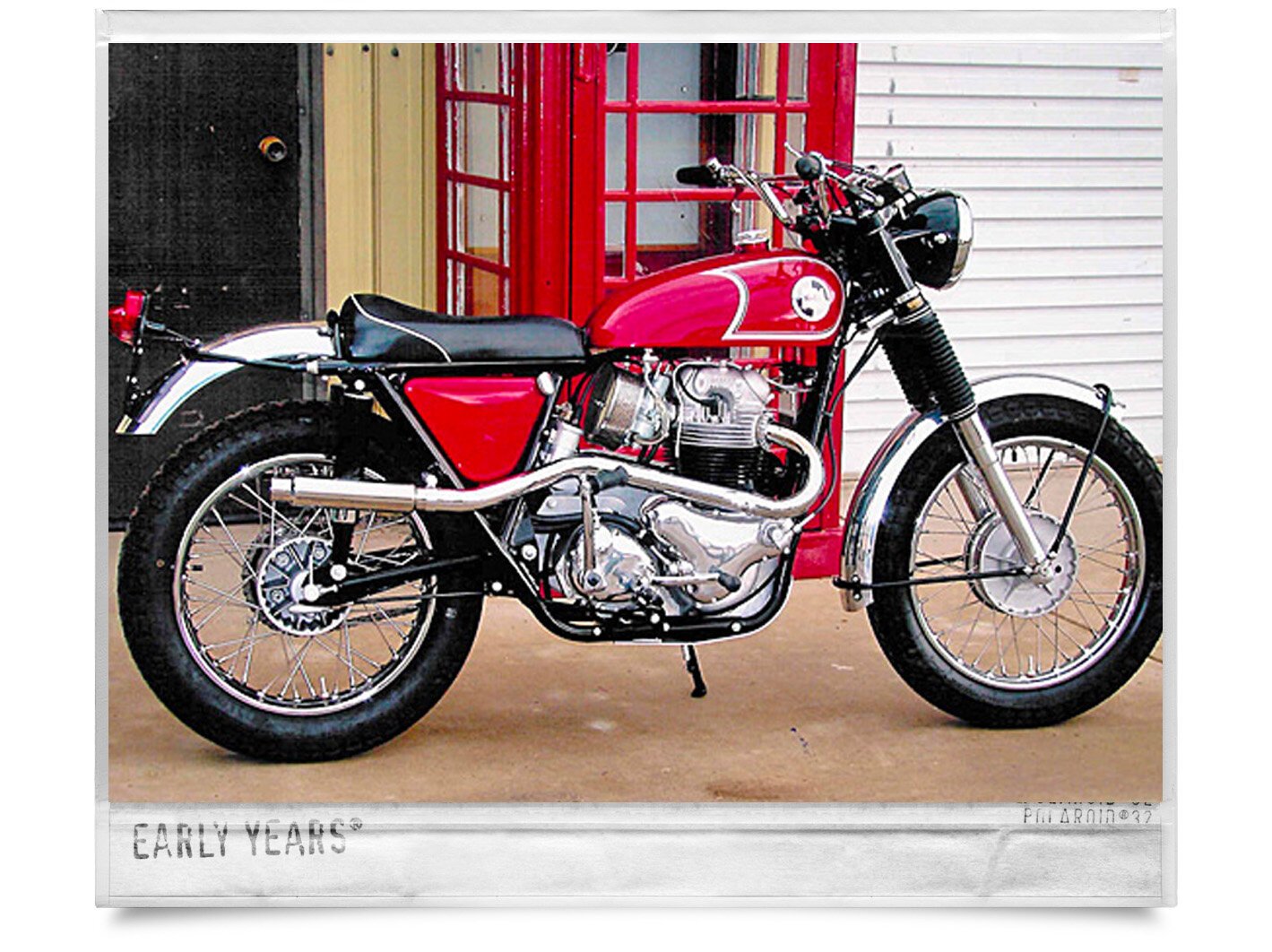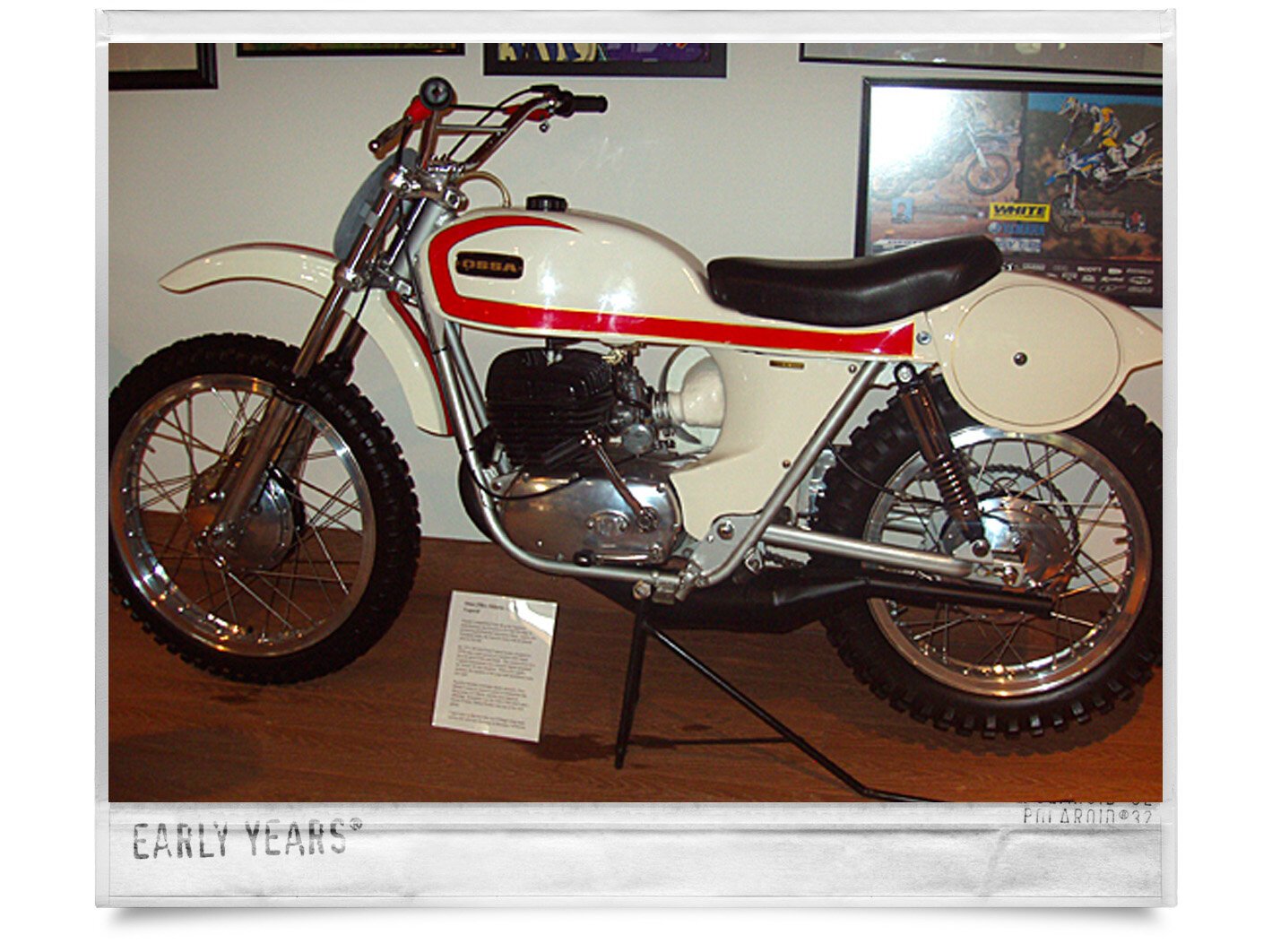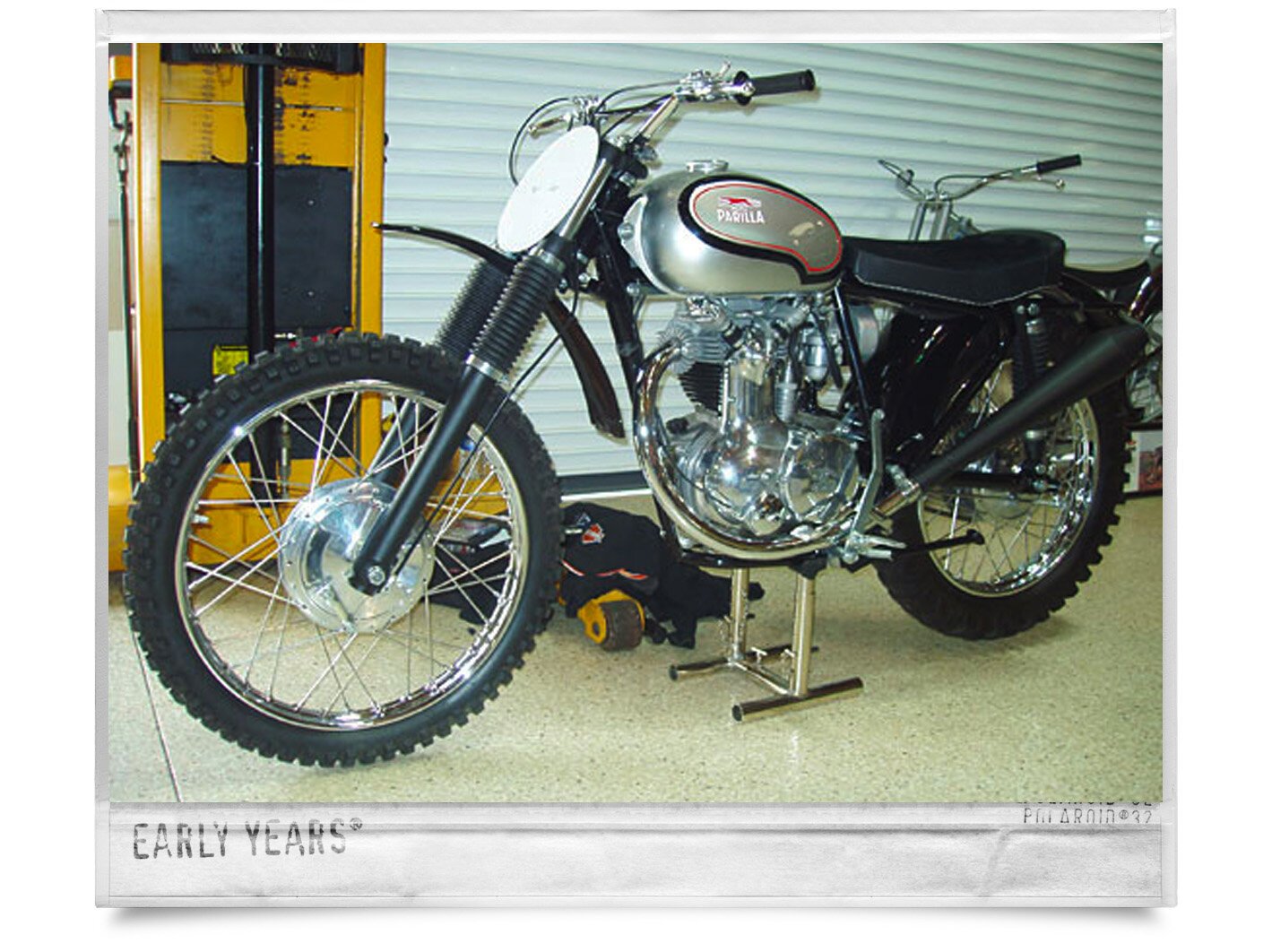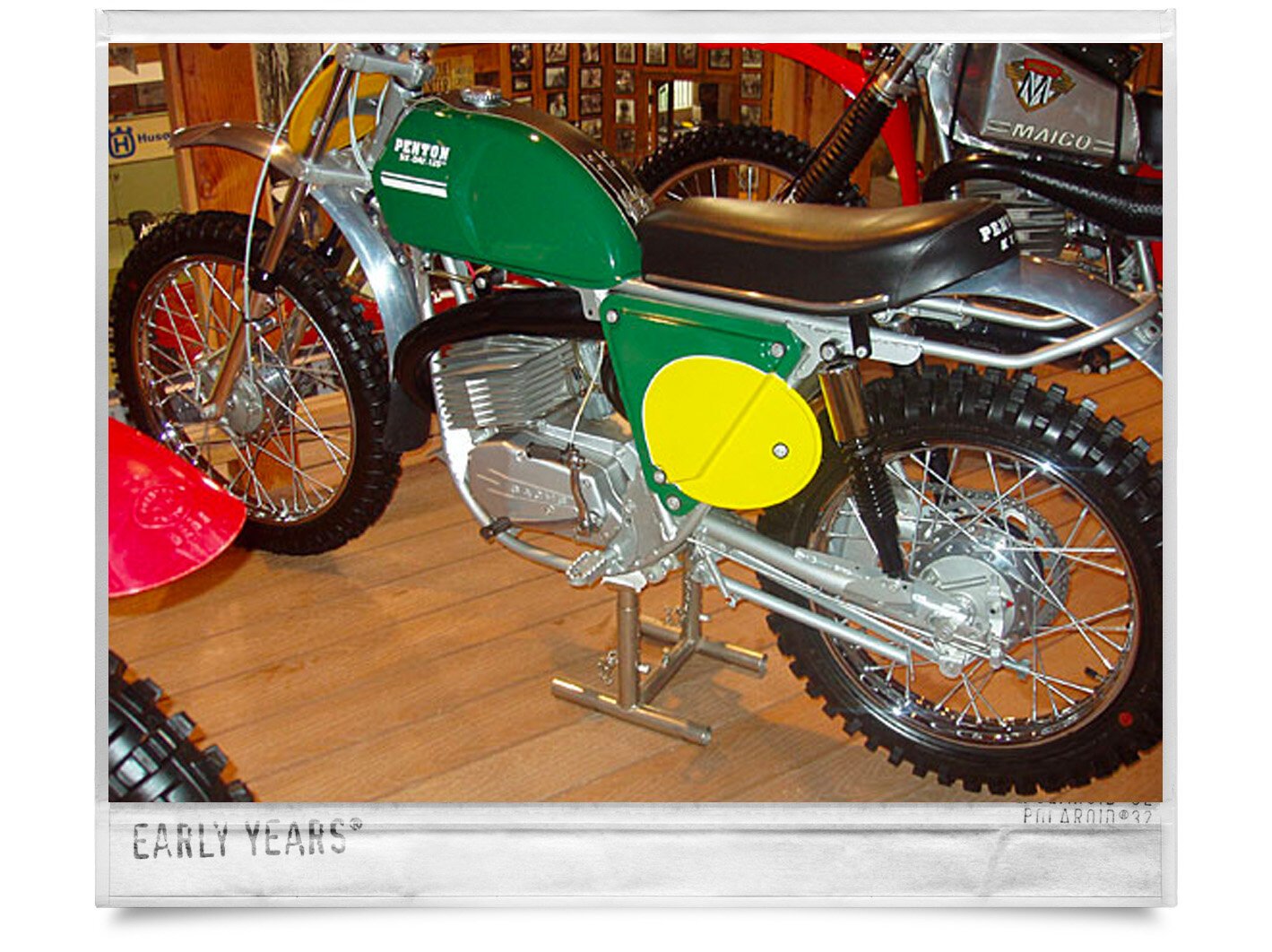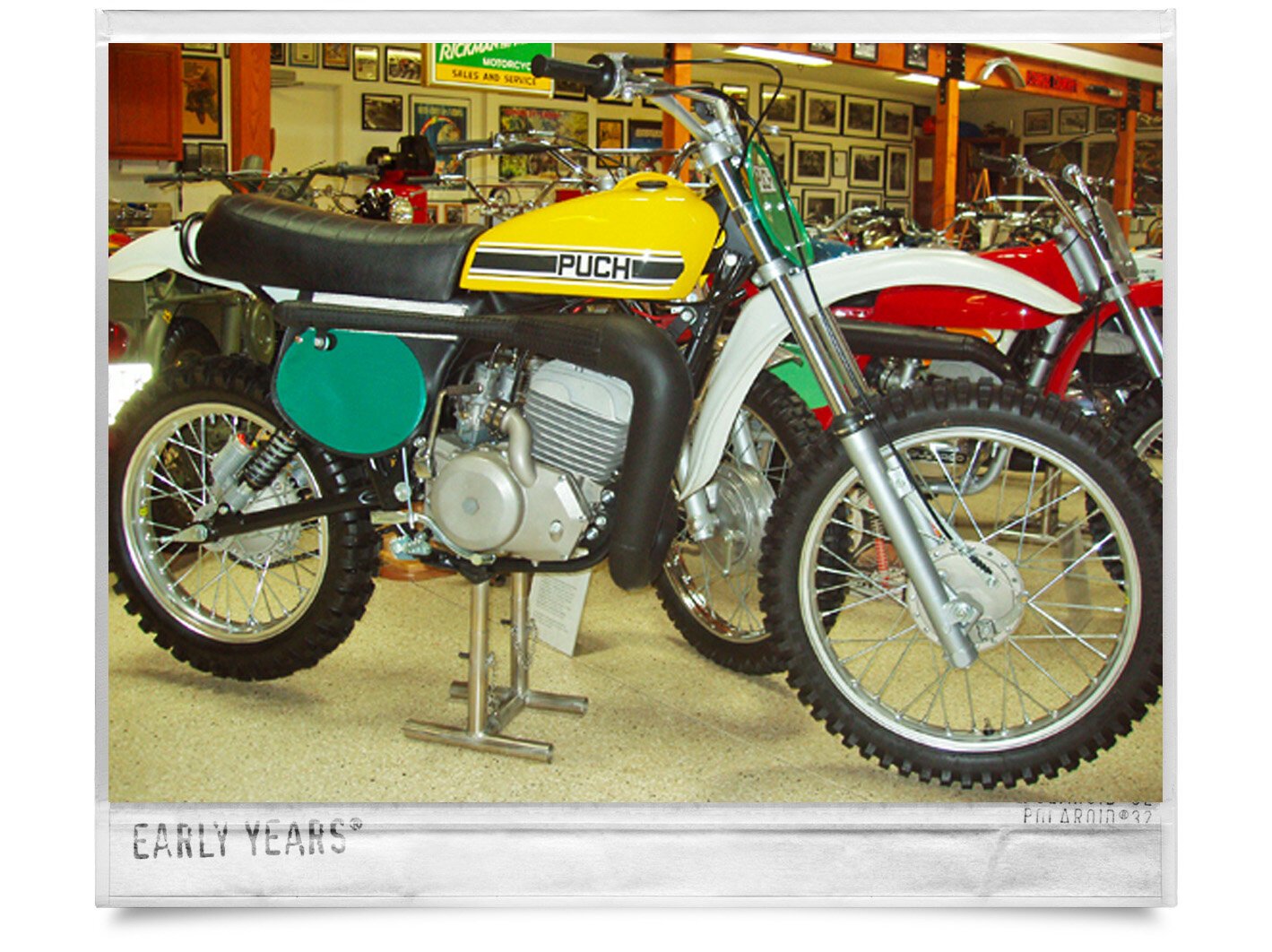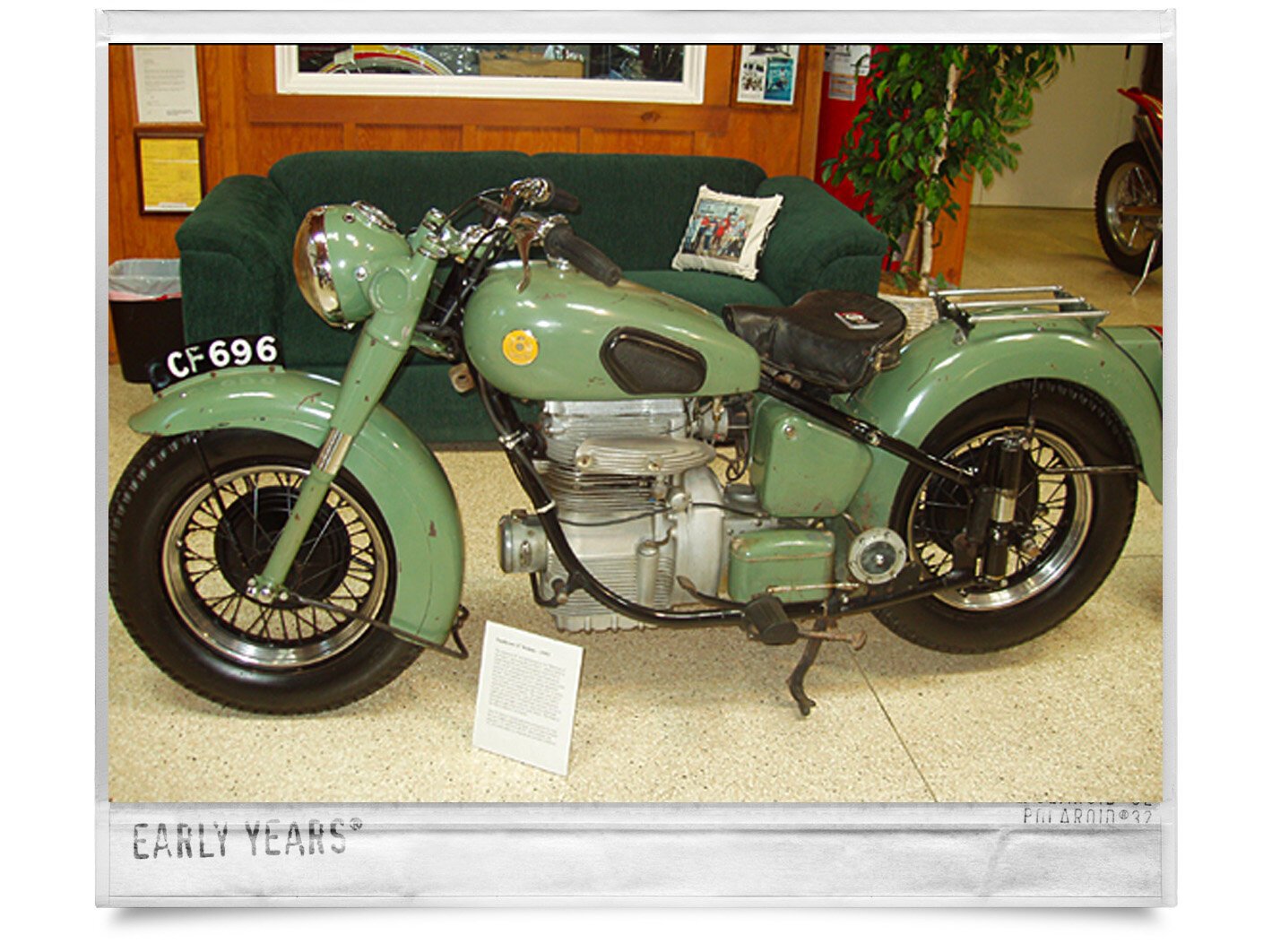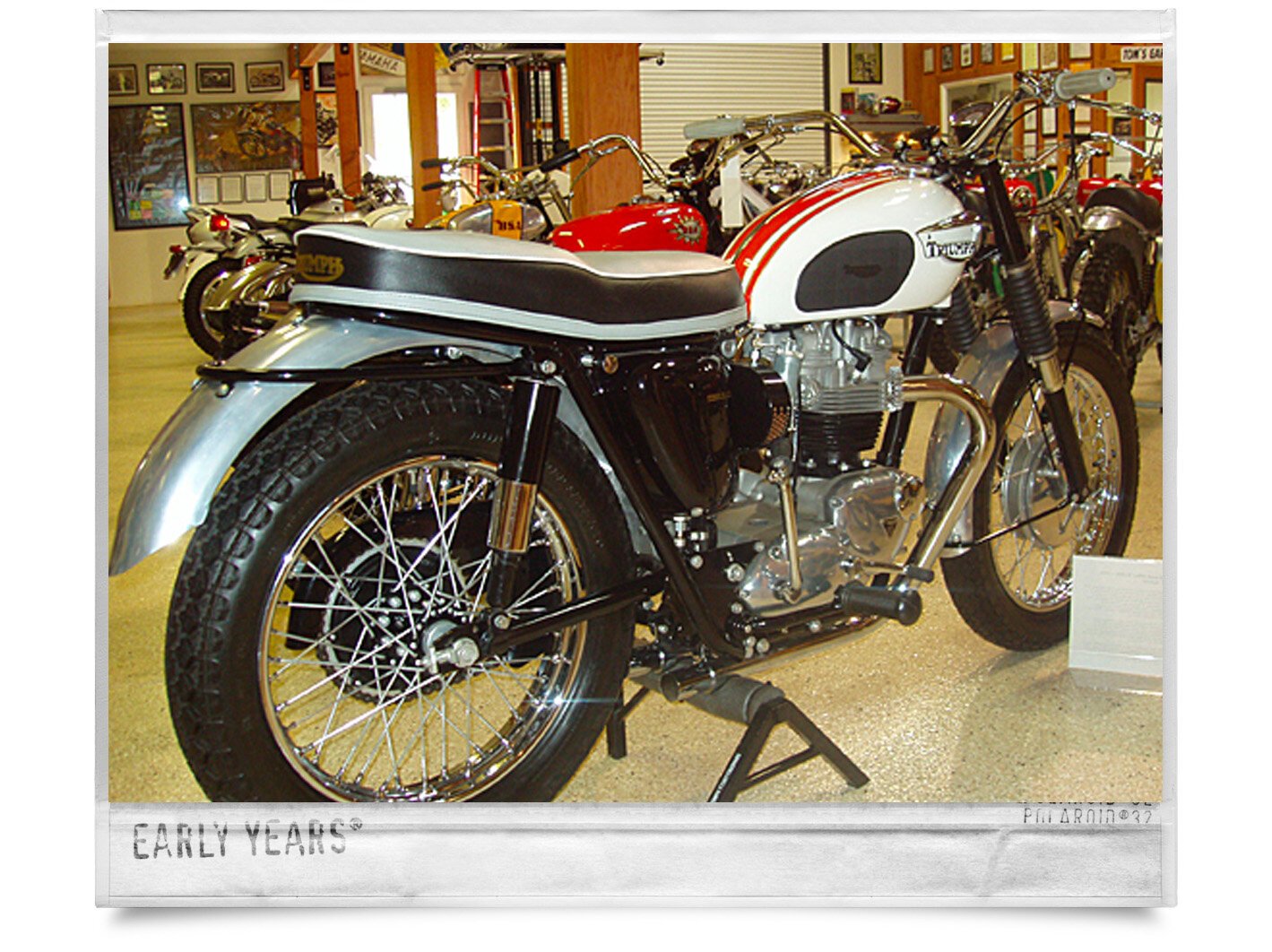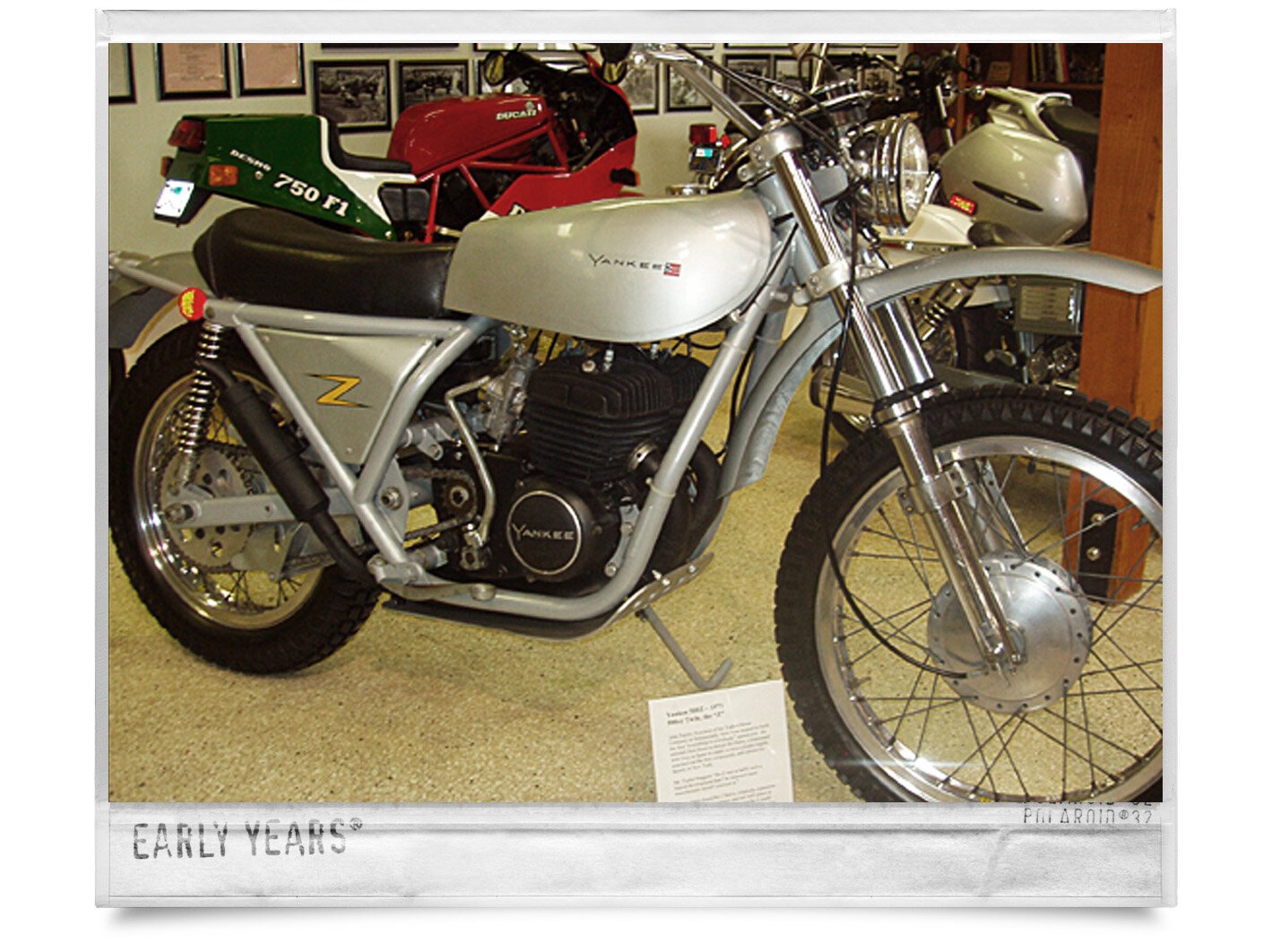SPRITE/AMERICAN EAGLE 405 TALON / 1971
American Eagle arrived on the USA motocross scene in 1967 with a big ad budget and small racing team (that included a young Brad Lackey). But, in truth, there was no American Eagle motorcycle factory. The American Eagle was a private-label bike that was built by Sprite Developments in Oldbury, England by Frank Hipkin. Brits could buy the bike as the Sprite 405 Talon, Americans were offered the bike as the American Eagle 405 Talon, Australians knew it as the Alron 405 and Belgiums thought it was the BVM 405. All the bikes were identical, with the exception of the American bikes having “American Eagle” cast into the engine case. Amazingly all the different national distributors tried to pretend that the Sprites were designed in the home countries. It wasn’t until many years later that each country learned the truth about the “other” Sprites.
Most distressing of the “clone engineering” behind the $1195 American Eagle 405 Talon was that the engine itself was a clone. It was an Italian-built copy of a late ‘60s, four-speed, 399cc, Husqvarna engine. Many Husqvarna parts would fit in the Italian engine, but not all. Most American Eagles racers remember the gearbox with particular distaste. Additionally the Talon had a Sprite-built fork that was a direct copy of a Ceriani fork.
Sprite Developments in England showed rapid growth from 1964 to 1974. Owner Frank Hipkin started building lightweight, Reynolds tubing frame kits for Villiers, Triumph Cub, Husqvarna and Maico engines. Amazingly enough, if Hipkin had kept the Sprite motorcycle company small he might have lasted longer. Success killed the Sprite, Talon, Alron and BVM. When Hipkin started exporting Sprites in large numbers the British government closed the tax loopholes that Sprite was using and, following the collapse of the U.S. American Eagle distributor (Galaxy Wholesale in Garden Grove, California), the financial losses were too great to absorb.
Today, Sprite Development still exists, but it builds RVs, caravans and motor homes.
WHAT THEY COST
Although it was quite rare to find the Sprite or it’s stepchilds on EBay, collectors don’t seem to be drawn to them. This un-restored example was purchased in 2006 for $2600. A good core (original but in need of restoration) Husqvarna of the same year would easily go for twice this amount.
MODELS
Eagle 125 – CMXR (125cc Sachs engine), Eagle 250 – GMXR (250cc Husqvarna clone), and the Eagle 405 – TMXR (405cc Husqvarna clone).
WHAT TO LOOK FOR
The Eagles came with several different fuel tanks (2.0gal or 2.5gal) made of either fiberglass or aluminum and either Dunlop Sports knobbies or trials tires. The side panels are aluminum as are the fenders and the front and rear hubs are polished aluminum. If these items are in good shape, the bike will make a beautiful addition to any collection.
PARTS SUPPLY
It is very difficult to find parts for the Sprites. Vintage Husky in San Marcos, CA at 760-744-8052 may be able to help. In Europe, try Frans Munsters at vintage@fmunsters.nl.
RICKMAN BULTACO 250cc / Petite Metisse / 1965
British brothers, Don and Derek Rickman as importers for Bultaco, and top motocross riders helped forge the Spanish companies way into the growing motocross market – circa early 1960’s. As early as 1963, Don Rickman delivered a crippling blow to the agricultural British 2-strokes when he became the only British finisher and 3rd podium position at the British Grand Prix. This was accomplished on a 196cc Bultaco engined and Rickman framed machine 50cc’s smaller than the competition.
The Petite Metisse, built in 1965 utilizes the new 250cc Bultaco engine, perfectly fitted into Rickman’s jewelry like frame and running gear. The collaboration between Bultaco and the Rickman brothers yielded a similar Bultaco manufactured Mk 1 Pursang that was down right crude in comparison.
This example is 1 of 24 bootlegged into the U.S. in pieces by Charlie Hockie and Bud Ekins. U.S. Petite Metisse’s were painted British racing green. This example was restored by Matt Hilgenberg.
AJS 250cc STORMER / 1972
So what was more logical for the born again Norton Villiers company of the mid 1960’s than to create and launch a purpose built motocrosser hot on the heels of its successful Norton Commando. The Stormer was based around a re-engineered version of the agricultural Villiers 2-stroke engine which had long been the mainstay of British 250 class competition.
Top British riders, Andy Roberton and Malcolm Davis were the development riders and a prototype was being raced as early as 1967, with first production in 1968.
The chassis featured several innovations that were way ahead of their time such as leading axle forks and the rear shock mounts mounted forward on the swingarm. Unfortunately, the dated Villiers engine kept the Stormer from being a strong seller.
To this day, new and never ridden Stormers, still in the crate, show up in the marketplace. Unfortunately for me, not finding one of the new (and in the crate) examples when I was ready to buy, this bike was restored by Vintage Iron at significantly more cost.
AMMEX 250cc MX / 1976
Gary Jones won four consecutive 250 National championships while racing for Yamaha, Honda, and Can-Am. When he suffered a leg injury at Daytona and Can-Am bought out his contract, Gary took the $70,000 and started his own motorcycle company. Not an easy task, but at the time, Cooper Motorcycles was going out of business, and the Jones family bought the Mexican based company and used the Frank Cooper designed enduro bike as a prototype for the first Jones-Islo (the name would later be changed to Ammex, which stood for American-Mexican).
Under Mexican law, 68 percent of the Ammex had to be manufactured in Mexico, so the pieces that would be out-sourced included Sun rims, Diamond chain, Mikuni carbs and ART pistons. To ensure that the Mexicans didn’t use pot metal in the castings and frame, Jones shipped American-made chromoly and aluminum to the Saltillo, Mexica, Moto-Islo factory. The Mexican metallurgy was always suspect, especially in the crankshaft and transmission.
The Ammex borrowed its plate-style shift system from Maico, the dual-use kickstarter/shift shaft from CZ and a Yamaha YZ250 top-end could be slipped right onto the Ammex cases.
Ammex had high hopes, but unfortunately the Mexican peso was devalued-dropping from 12 pesos to the dollar to 120 pesos in less that a week. Since Ammex was a Mexican company, it was worth one-tenth of what it was the week before. Gary Jones lost his money and his dream of building his own motorcycle. Productions dribbled on a few years, but after the devaluation in 1976, the company was doomed.
BRIDGESTONE SR175 TWIN / 1967
By the 1960’s, Bridgestone was a one of Japan’s largest companies, building cars, bicycles, motorcycles, and of course – tires. The motorcycles were technically a step above the competition, but the higher price and the choice of Rockford Motors in Rockford, Illinois as the distributor probably hurt sales. By 1971, Bridgestone was out of the motorcycle business.
The SR175 was a hand assembled factory racer, with features like dual rotary valves, polished ports, stuffed crank and a tube steel frame. Quarter mile performance was listed on the brochure as 15.3 seconds – fast!
It’s amazing that this model never really took off in popularity; especially in scrambles were there was a 200cc class.
This machine is unrestored and in original condition. Check the tires – very little time on this little jewel.
CAN-AM 250cc MX2 / 1975
Known affectionately as the “Canned Ham,” the Canadian-built Can-Am MX2 was a uniquely different machine from what was offered by the Japanese and Europe marques. The Austrian-built Rotax engine used a rotary valve intake system. The 32mm Bing carb was mounted behind the engine and the fuel was fed to the lower end via a tuned 30mm aluminum tube. The smaller intake tract increased fuel velocity so that when the pie-shaped rotary disc opened up the fuel would go directly into the lower-end. Rotary valve engines enjoyed popularity in the early 1970s on Kawasaki dirt bikes, most notably the 350 Big Horn, and on later-generation four-cylinder two-stroke road race engines. A unique feature included a gauze-type air filter that sat on top of a still-air box (air was drawn into the engine via a vent where the rear fender met the seat).
The 1975 Can-Am MX2 was based on the bike that Gary Jones, Marty Tripes and Jimmy Ellis used to sweep the 1974 AMA 250 National Championships.
COTTON COBRA 250 / 1965
The Cotton marque was actually founded in 1918 by Frank Willoughby Cotton as a sporting street motorcycle with a unique for its time triangulated steel tube frame. It wasn’t until 1961 that Cotton which had gone through several ownership changes entered the scrambles market. At that time the 250 Cougar Scrambler was introduced and a works racing team was formed with riders Bryan “Badger” Goss and John Draper.
Though the Cottons were similar in many ways to the Greeves and DOT motorcycle that were also manufactured in England with proprietary components, several features quickly distinguished the Cougar Scrambler. For one, the Villiers engines were set back and down in the frame and used the lightest tubing available. Match this with the very beefy Armstrong leading-link front forks and you had a very different, if not ugly motorcycle.
The theory of keeping the main weight distribution over the rear wheel and the center of gravity low, worked well in practice, though riding a Cotton was an acquired taste. These were low ground clearance wheely machines which needed to be ridden solely on the rear wheel.
The American models came with a 19” front wheel and an 18” rear wheel with the Metal Profile hubs used by most of the English manufactures. The power plant was standard issue Villiers Starmaker engine with claimed horsepower output of 26 at 6000 rpm’s and a 4-speed gearbox. Rear shocks were by Girling, fenders were chromed steel, and the standard fuel tank was a 2 _ gal steel tank though a 1 _ gal fiberglass was available for motocross.
Any hopes of real motocross racing success came in 1964 when BSA factory rider Arthur Lampkin switched over to the Cotton brand for a few races. Unfortunately he wasn’t impressed and returned to BSA to finish his career. Cotton sales never took off in America and the company closed down in 1980.
DKW 125 MOTOCROSS / 1971
This German machine was produced about the same time that corporate restructuring transferred ownership interests in the bike from Sachs to DKW. The engine cases carry the Sachs name, while the tank badges reflect DKW’s proprietary interest.
The two-stroke single was specifically built to be a contender in the 125cc motocross class, which was in growth mode and destined for world championship status starting in 1975.
The DKW was quick and its leading-link Bode front suspension added to its stability. At $750 retail it was considered pricey, but it delivered quality commensurate with its cost.
The DKW name dates to the early twentieth century and originally stood for Dampf Kraft Wagen or steam-powered car. Later variations included Des Knaens Wunsch (the boy’s wish) and Das Kleine Wunder (the little miracle). Whatever DKW stood for in the German language, it stood for quality small-displacement motorcycles in the early 1970s marketplace.
ESO 500cc Moto-Cross / 1959
Black Swan or ugly duckling – a question of perspective on this Czech scrambles machine manufactured near the Jawa factory. Eso’s were always limited production machines that ended up in the hands of the best club racers and GP riders. This helped create a mystique that lives to this day.
Taller, longer, and a little heavy compared to the British 4-strokes, the ESO was fast! The engine, the masterpiece of the ESO, was well ahead of it’s time in terms of engineering. Straight cut gears (no primary chain), unit construction, and a crankshaft that spins backwards are amongst the unique features of the ESO. The chassis measures 1” longer than the Goldstar and other popular 4-strokes and when combined with a few more degrees of rake, is a slow responder. Better find a berm!
This example is a 2-time Del-Mar Concours show winner that I’m sure you will enjoy.
Matchless 500cc G85CS 4-Stroke Scrambler / 1966
Too little (or possible too much), too late. That could probably be said about the Matchless G85CS Scrambler. As one of the last models of Matchless to be made, it was the last (and best) attempt by the British to build a 4-stroke scrambler capable of beating the light-weight 2-stroke machines that were dominating the European Scrambles scene.
It’s easy to see the Rickman brothers influence in the design of the frame. The G85 was a duplex design with lightweight forks, machined front hub, magnesium rear hub, and as many lightweight fiberglass and aluminum components as possible utilized. Though Matchless claimed 291 lbs, actual weight was nearly 320 lbs, much heavier that the 2-stroke competition.
The G85CS looked and sounded magnificent, but was not particularly fast and when combined with the weight, missed the mark.
This is one of my favorite motorcycles! Lovingly restored by British specialist Don Harrell.
Mondial 200cc Motocross / 1952
The Italian company – Mondial (French for World) was started by the Bosselli brothers in 1948. The first prototype, a 125cc dual overhead cam roadrace bike, was the basis for future racing machines. The engine was designed by Dr. Fabion Taglione who became the founding engineer for Ducati. In 1949, the first year in full production, the twin-cam engined Mondial roadracer won the 125cc World Championship. Racing success continued in 1950 and 1951 with two more World Championships – MV Augusta was the main competitor. Mondial was primarily a roadracing company, but did manufacture 7 or 8 125cc MX machines in the early 1950’s. These motorcycles were never in production, but instead, raced by factory riders. The Mondial motocross machines won a single Italian National Championship in 1952 racing against Moto Guzzi and Aeromachi. Unfortunately, the Mondial motorcycle company in Rimini, Italy was out of business by 1958.
The Mondial 200cc you are looking at was built by a factory employee with the permission of the Bosselli brothers in 1952 for campaigning privately. Purchased from Rick Weedon, Edoardo Vannucchi, a well-known motorcycle restorer in Italy brought it back to original condition.
MJS Trials
INFO COMING SOON.
Norton P11 750cc Scrambler / 1967
The Norton P11 was built as a U.S. market only machine mating the powerful 750cc Atlas engine with a frame that resembled the “Metisse” frame built by the Rickman brothers. Wedded to the Matchless forks and other running gear, it produced a ride quite unlike any scrambler built at the time.
With a power output of 52 _ horsepower the machine was quite a potent race bike (when street gear was removed) and won several desert, scrambles, and TT races with capable riders like Mike Patrick and Jack Simmons.
Unfortunately, the relatively high price tag of $1339 and Norton’s lack of popularity compared to BSA and Triumph offerings from England led to poor sales. The P11 was quickly replaced in 1968 by the P11A that was more of a street going machine with low pipes and more weight to lower the cost.
This rare machine is owned by the Early Years of Motocross Museum and was meticulously restored by Don Harrell. Please enjoy!
Ossa 250cc Stiletto 5-speed / 1971
Despite competition from the giant Japanese manufactures, the Europeans still had the edge in producing professional motocross bikes. And in the European ranks, the Spanish Ossa must be placed close to the top.
By 1971, the new Ossa 5-speed model (4-speed in 1970) was a well sorted out machine with classic Spanish good looks and finish. The combination of a 5-speed transmission and a torquer engine prepared the Stiletto for any situation. With a low saddle position, the location of the pegs and handlebars were just right.
Possibly because a stronger dealer network, Ossa Stiletto’s sales in America paled in comparison the Husqvarna, CZ, Maico, and the new Japanese offerings. Scrambles was the Ossa’s best nitch and a friend of mine, Danny Hockie was one of the best pilots.
I was lucky to find this bike at a Vintage swap meet held at the Infinium Raceway in Sonoma, California.
Parilla 250cc Wildcat Scrambler / 1962
Most serious Italian motorcycle collectors will concede that Parilla has become somewhat of a “Cult” collector bike for those who appreciate one of the most beautiful engines ever designed. The Wildcat is a “high cam” 250cc hot rod that came with the high performance road race engine that was used in the very expensive Grand Sports model. Parilla’s are considered much rarer than their competitor – Ducati.
Only a handful of the Wildcat Scramblers were imported in America by the U.S. importer Cosmopolitan Motors in Pennsylvania and were ridden primarily in scrambles events if they were raced at all. Note the quick detachable hand-formed tank, the beautiful suede seat, and the unique painted fenders. The “high cam” engine is fueled by a remote float Dellorto carburetor and exhaust utilizes a reverse cone megaphone. Performance four-stroke all the way!
The restoration was handled by Vintage Iron who considers it one of their best.
Penton 125c Motocross / 1973
There are very few truly American motocross bikes. In fact the closest Yankee pride ever came was the Rokon 340 Cobra campaigned by “Rokon Don” Kudalski – although it used an Austrian engine. The near misses include Gary Jones’ Mexican-made Ammex, Harley Davidson’s Italian-built MX250, Frank Cooper’s Mexican-manufactured Cooper Enduro, John Taylor’s Spanish built Yankee Z, and John Penton’s Austrian-built Penton 100cc Berkshire, 125cc Six-Day, 125cc Mud-Lark, 175cc JackPiner and 250cc Hare Scrambler.
After returning from World War II, John Penton started competing in off-road events on a Harley Davidson. He soon realized that a special motorcycle was needed to compete in torturous events like the Jack Pine Enduro. His early endeavors would make him one of the greatest innovators in American motorcycle history.
After winning the Jack Pine in 1967, John Penton became the Eastern U.S. distributor for the Swedish brand – Husqvarna. Soon after, Penton visited the KTM factory and proposed that the Austrians build an off-road bike of his design. Amazingly, KTM agreed and the first ten 100cc Pentons were delivered in March of 1968. There was an immediate demand for the $700 Penton and in the first year 400 Pentons were sold.
Famous Penton riders included Dane Leimbach, Jack and Tom Penton, Bill Uhl, and Carl Crank. The first 125cc Motocross National, held at Arroyo Cycle Park in 1973 (now Glen Helen), was won by Penton rider Ray Lopez.
From its humble start, Penton became a powerhouse, selling more than 25,000 motorcycles in American.
Puch 250 Twin-Carb – Harry Everts Replica / 1975
The Austrian Puch company hired Belgium motocross rider Harry Everts in 1974 to compete in the FIM 250cc World MX Grand Prix’s. Though he had many top finishes that first year, it wasn’t until 1975 that Everts and the Puch found true racing form. Evert’s rewarded Puch with its first World Championship in motocross.
It was no small feat for a European company to win the championship, especially in only its second year of competition against the dominate Japanese Suzuki’s that had won four 250cc championships in a row. The factory Puch was a spectacular machine! Marzocchi front and rear suspension with an all new design frame, generous use of magnesium in the motor, hubs, and forks, and a very unique “twin carb” design with one Bing carburetor feeding a traditional piston port and a second carb feeding a rotary valve on the right side of the engine.
The Puch factory is the only company to every reproduce the factory works bike in significant numbers. 90 machines were built in 1975 and sold to wealthy owners in 1976.
Please enjoy this Frans Munsters restored classic! I’m quite sure this is the nicest example in the world!
Sunbeam S7 Deluxe / 1953
The Sunbeam S7 was designated as the “Machine of the Future” following World War ll. Built in BSA’s Small Heath Works in Birmingham from 1948 to 1956, the S7 was designed by Erling Poppe as an exercise in adopting automobile theory to motorcycle design. The Sunbeam S7 was a unique departure from post-war motorcycle architecture with its inline, twin cylinder, overhead cam, dry clutch, shaft-drive and rubber mounted engine. The engine is a 487cc in-line, air-cooled twin, with all-alloy construction, right-side shift and coil/distributor ignition. Power is transferred through a car-type final drive shaft and through a right angle to the back wheel. The heart of the bike’s charm is its engine.
This S7 Deluxe was bought new in England by Jody Weisel’s father and flown home in the back of a four-engined U.S. Air Force KC97. The machine has 13,263 miles and is in original un-restored condition.
Triumph 650cc T120TT Special / 1966
Riders such as Skip VanLeeuwen, Dick Hammer, and Eddie Mulder were winning races at Ascot Park in Gardena, California in the mid 1960’s on special ordered machines from the factory in England. Yes, the Triumph TT Special was conceived by Pasadena’s Johnson Motors, and it was a purpose built California design built by Triumph. They came east eventually, but later.
The TT Special was a hot-rod. Nothing but the essentials, with engine modifications over the Bonneville (the street model) that included more compression and performance camshaft grinds that assured more than adequate power to compete against the Harley’s and BSA’s.
My first “big bike,” was a 1964 Triumph 650cc that I raced locally and later at the famed Ascot track. This example was purchased from Tom Tyson in North Carolina and, as you can see, he restored it meticulously to like new condition.
White 250cc Tornado Scrambler Motocross / 1966
You needn’t ask why I had to have a White in my collection. Jack White contracted the Csepal Motor Works in Hungary to build this unique motocrosser in 1965. White Motors, located in Santa Ana, California actually imported several different models of motorcycles that included 125 and 250cc offerings for street, scrambles, and motocross.
Check out the completely non-adjustable handlebars, rigid footpegs, heavy-duty brake and shift pedals, the 3-piece swingarm, and the flat expansion chamber. Also nice to know that at speed you can look down and see what gear you are in.
In 1967, White Motors advertised that the prototype 250 Tornado won its class at the Cherry Creek National. Apparently this wasn’t enough to convince buyers to purchase these old-world crafted machines as production ceased in 1968.
My friend Dave Boydsen of AMS provided this machine and Vintage Iron did the restoration.
Yankee 500Z Twin / 1971
John Taylor, President of the Yankee Motor Company in Schenectady, New York wanted to build the first “everything to everybody” motorcycle. He enlisted Dick Mann to design the frame, collaborated with Ossa in Spain to supply a twin-cylinder engine, searched out the best components, and opened his factory in New York.
Mr. Taylor bragged, “the Z was actually such a logical development that I’m surprised more manufactures haven’t pursued it.”
In use, riders found the Z heavy, relatively expensive compared to other machines, and not well suited to any specific application. It was hoped the Z could compete successfully in everything from road racing to motocross. Unfortunately it was too slow for road racing and too heavy for mx. When the factory closed in 1974, many Z’s were still in the warehouse unsold. Total production was in the seven hundreds.
Nice example, but 86 original miles? I doubt it!

